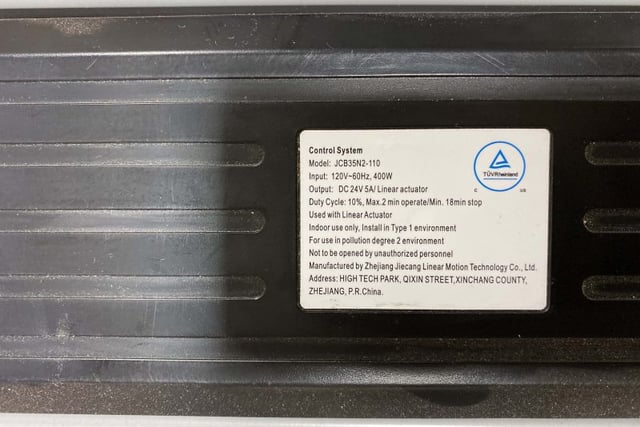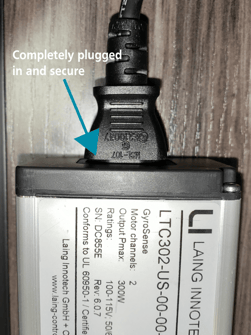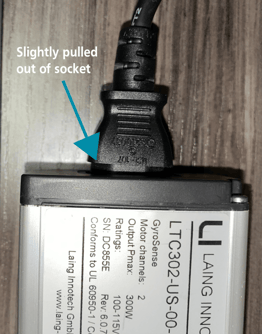Everyone loves using technology up until it stops working, and if you landed on this article, you're standing desk isn't working and you're not exactly feeling the love.
Given the fact that the desk has electrical components, at one some point, it's normal that you experience a hiccup. The most common issue is that the electric sit stand desk stops going up or going down. The desk just becomes stuck.
In this blog, I’m going to share the most common reasons a standing desk won’t go up or down and how to fix it. Keep reading to find out how to get your desk back in working condition.
Standing desk won't go up - causes & solutions
4. Too much weight on the desk
Standing desk won't go down - causes & solutions
2. Too much weight on the desk
Why your standing desk won't go up & how to fix it
1. Object is in the way
You may have something that's mounted above the desk that's stopping it from traveling upwards. The typical culprits are mounted shelves, cabinets, or artwork.
As a safety measure, many standing desks have a collision detection feature that prevents the desk from hitting another object. When it detects an object in the way, the table will stop moving upwards and then slightly move down, giving you room to remove whatever is in the way.
How to fix this
Check for any items above your desk that may be getting in the way, and remove them.
2. Standing desk lost power
This typically happens for one of two reasons: the desk was temporarily unplugged and plugged back in OR the outlet lost power.
In many cases, when a standing desk loses and then regains power, it automatically goes into reset mode. While being in reset mode, a sit stand desk can only travel downwards.
How to fix this
To get your table to move up, you must complete a manual reset on the table.
Learn how to reset your sit stand desk here.
3. The legs are uneven
Over time, the legs on a standing desk with two (or more) motors can become a bit uneven.
If the motors don't have a good self-locking mechanism, the motor and spindle can turn when it's supposed to maintain its height position. While one motor may turn, the second will either remain still or turn more/less than the first motor. Now, the motors are out of sync and your desk is uneven.
Once the desks become uneven, one of two things can happen.
1.) The desk's control box (the brains of the desk) finally recognizes that the legs are at different heights and it will stop moving up to prevent any more damage to the desk.
OR
2.) The control box isn't sophisticated enough to recognize the issue, and the desk will continue to move up and down until there's too much friction within the leg columns, get stuck, and stop moving.
How to fix this
The desk must do a complete reset in order for the leg to be realigned and even.
Learn how to reset your sit stand desk here.
4. Too much weight on the desk
Every height adjustable table has a maximum lifting capacity. If your desk is trying to support too much weight, an overload can occur. The desk is saying “this is too much work for me to go higher,” and to protect its components, it shuts off.
How to fix this
To fix this, just remove some of the weight from your desk. Once you take off enough weight, the desk should automatically turn back on and begin functioning as normal. There’s typically no need for a manual reset.
To help prevent this from happening again, research the lifting capacity of your standing desk. Pay special attention to whether that number is base only or base + worksurface. For example, if the manufacturer states “Total Lifting Capacity Base Only: 325 lbs,” that means whatever you put on top of the base (worksurface, monitors, keyboard tray, etc.) cannot exceed 325 lbs.
5. The control box cycles out
A table’s control box can only go up and down so many times before it needs to rest. This is something that’s referred to as the Duty Cycle. The Duty cycle tells us the maximum amount of time the control box can be active (moving the desk up or down) and how long it needs to be inactive (in its rest stage).
If the control box reaches the maximum amount of active time, it will turn on a mandatory rest period to prevent overheating. So, when you’re desk stops working all of a sudden, don’t panic.
Below are two different control boxes - one made by TiMOTION and the other by Jiecang. The duty cycle for both of them are 10%, 2 minutes on and 18 minutes off.


How to fix this
First, just wait and give your standing desk about 18 minutes of rest (the average amount of time required by most control boxes). Your desk may turn on before 18 minutes has gone by.
Often times, the table will turn back on once it’s had a break. You can then go on using it as normal.
If you’ve tried that and it doesn’t work, complete a manual reset. A manual reset can override the cycle time resting period that’s currently turned on. Even after you complete the rest, you should still allow the desk to rest.
Click here for the reset instructions.
6. The power, control box, or motor cables are loose
The power, motor, or control box cables can become loose by getting tugged on or stuck. The cause of the tug is often due to a lack of wire management.
A cable can be pulled out of the socket ever so slightly and still cause power to be intermittent. See the images below to see how to better identify if a cable is securely inserted.


When the cables become loose, the power within them becomes intermittent, meaning that sometimes the power can flow through them and sometimes it can’t. For many desks, every time the power is lost, the table will go into reset mode.
How to fix this
Before you reset your sit stand desk, check all cables to make sure they’re securely connected. Once you’ve done that, go ahead and reset the desk. Click here for the reset instructions.
To help prevent this problem, use a wire management solution to keep wires out of the way. There are a variety of options available so you can find the one that best suits you.
7. Desk has an upper container stop
An upper container stop is a setting a user creates to reprogram the desk’s maximum height. So, instead of being able to go to 48”, you can set the max. height to 40”. They’re used to prevent collisions between your sit stand desk and another object, like a cabinet or shelf.
How to fix this
You will need to either change or delete the upper container stop to make the table go up past the current setting. To do that, follow the instructions provided by the desk’s manufacturer.
Why your standing desk won't go down & how to fix it
1. Object is in the way
There may be an object below the desk that's stopping it from going down. Common objects include chairs, mobile pedestals, file cabinet, etc.
Many standing desks have a collision detection feature that prevents the desk from hitting another object and causing any harm or damage. When it detects an object in the way, the table will stop moving downwards and then slightly move up, giving you room to remove whatever is in the way.
How to fix this
Check under your desk and remove any object that may be blocking its travel.
2. Too much weight on the desk
Every height adjustable table has a maximum lifting capacity. If your desk is trying to support too much weight, an overload can occur. The desk is saying “this is too much work for me to lift” and to protect its components, it shuts off.
How to fix this
To fix this, just remove some of the weight off your desk. Your desk should automatically turn back on and begin functioning as normal. There’s typically no need for a manual reset.
To help prevent this from happening again, research the lifting capacity of your standing desk. Pay special attention to whether that number is base only or base + worksurface. For example, if the manufacturer states “Total Lifting Capacity Base Only: 325 lbs,” that means whatever you put on top of the base (worksurface, monitors, keyboard tray, etc.) cannot exceed 325 lbs.
3. The control box cycles out
A table’s control box can only go up and down so many times before it needs to rest. This is something that’s referred to as the Duty Cycle. The Duty cycle tells us the maximum amount of time the control box can be active (moving the desk up or down) and how long it needs to be inactive (in its rest stage).
If the control box reaches the maximum amount of active time, it will turn on a mandatory rest period to prevent overheating. So, when you’re desk stops working all of a sudden, don’t panic.


How to fix this
First, just wait and give your standing desk about 18 minutes of rest (the average amount of time required by most control boxes). Your desk may turn on before 18 minutes has gone by.
Often times, the table will turn back on once it’s had a break. You can then go on using it as you normally would.
If you’ve given the table adequate rest time and it still won't go down, complete a manual reset. A manual reset can override the cycle time resting period that’s currently turned on. Even after you complete the rest, you should still allow the desk to rest.
Click here for the reset instructions.
4. Desk has a lower container stop
A lower container stop is a setting a user creates to reprogram the desk’s minimum height. So, instead of being able to go all the way down to 24”, you can set the minimum height to 28”. They’re used to prevent collisions between your sit stand desk and another object, like a chair or mobile pedestal.
How to fix this
You will need to either change or delete the lower container stop to make the table go up past the current setting. To do that, follow the instructions provided by the desk’s manufacturer.
5. Standing desk is malfunctioning
Unfortunately, there may be a problem with the desk's internal components.
Use the checklist below. This can help determine next steps to get your desk functioning again.

How to fix this
If you’ve checked off all 7 boxes, you’ve exhausted every solution you can do on your own. Contact the desk’s manufacturer and ask their support team about solutions to get your desk back in working condition.
Fixing your standing desk can be overwhelming. Start here.
There are many different reasons why your standing desk is getting stuck, and it can be challenging to find the correct way to fix it.
This list may not include every reason for why your sit stand desk won't go up or down. The table may not be assembled correctly or there may be other manufacturing defects.
However, this list does share the most common causes and solutions and is a great place to start when you first notice that your desk won't move.
If you were to call your desk's manufacturer, technical support likely go through this same troubleshooting list that we went through in this article. Tackling these common causes first on your own can either completely solve the problem, or help save you time on the phone with tech support if it happens to be a malfunctioning issue.
How to Reset a Standing Desk
Please note that these are general instructions that work to reset most sit stand desks. Be sure to first read the manufacturer’s reset procedure before starting.
- Remove anything from under the desk that may obstruct travel.
- Unplug the desk from the power outlet and wait 30 seconds.
- Check all other cords for the desk's motor or control box and make sure they're secure.
- Plug the power cord into the wall socket.
- Press and hold the down arrow button (▼) until the table reaches its lowest position. Then, release.
- Press and hold the button again for 10 seconds. Then, release. You should notice that the desk dips down and slightly rises, and then stops (indicating a successful reset).
- Release the button and resume normal use of your desk.
Safety Reminder: When in reset mode, programmed container stops and anti-collision features are turned off. So, before you begin lowering the desk, make sure objects that could block the travel are removed.


COMMENTS